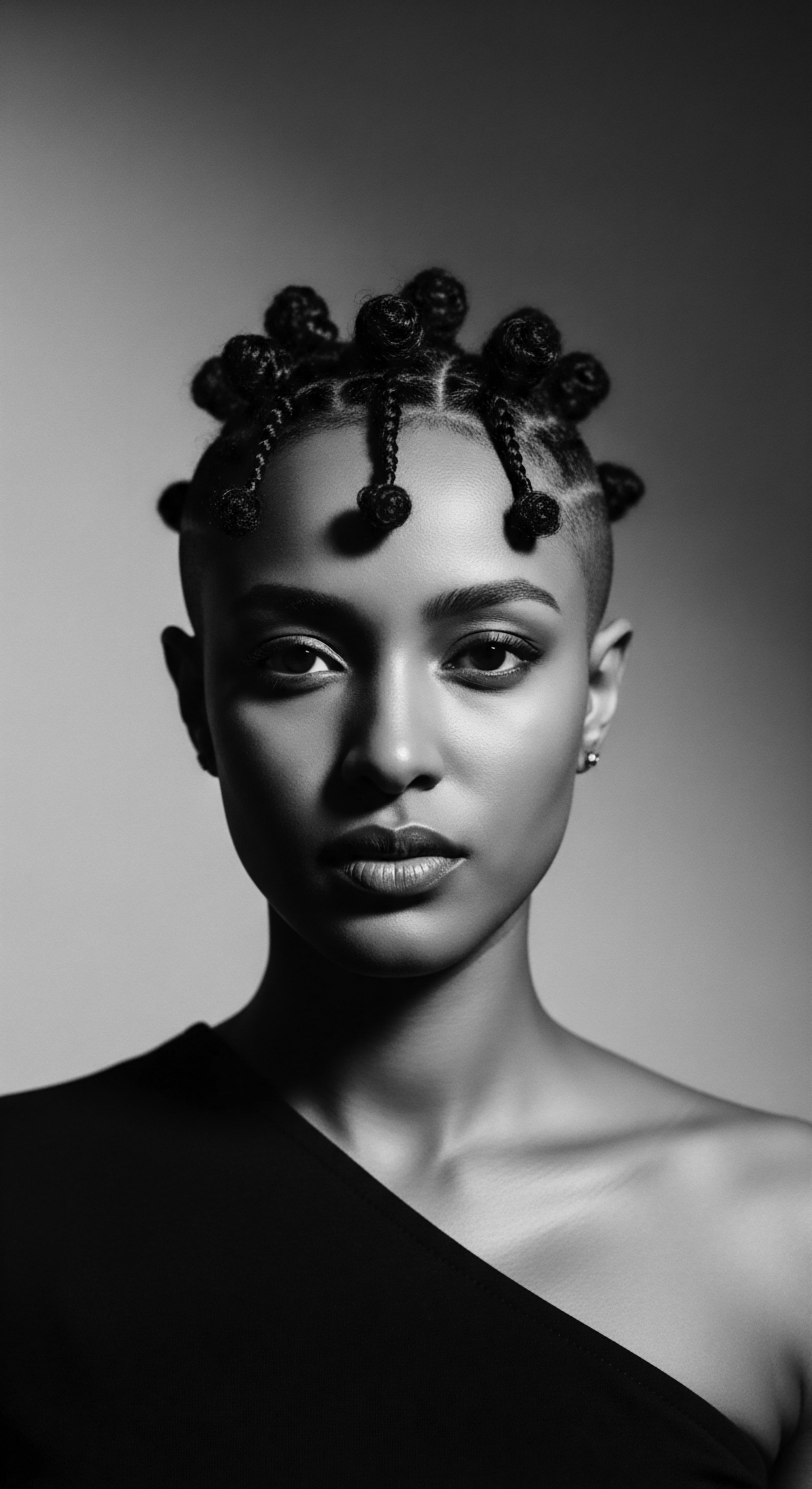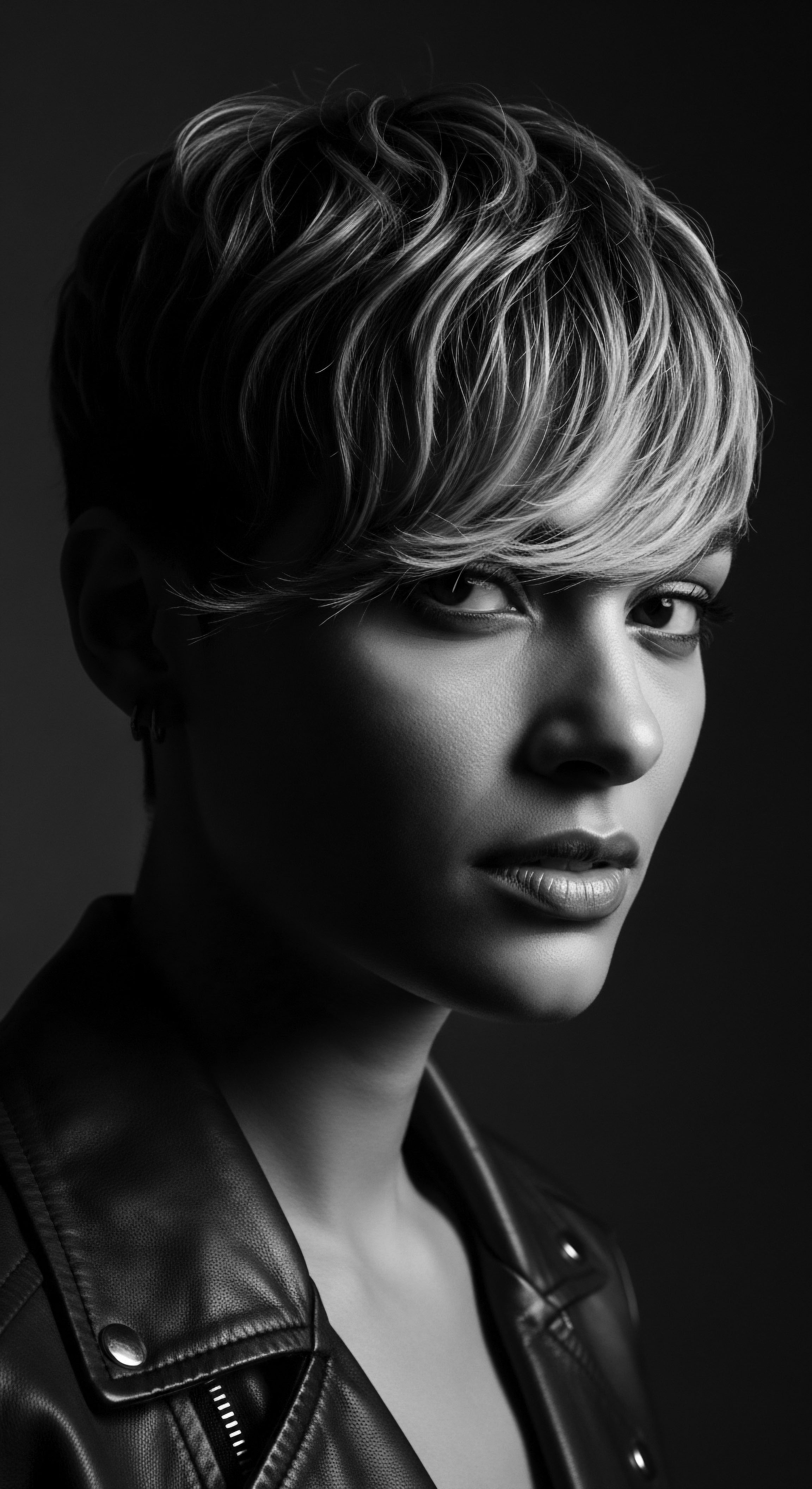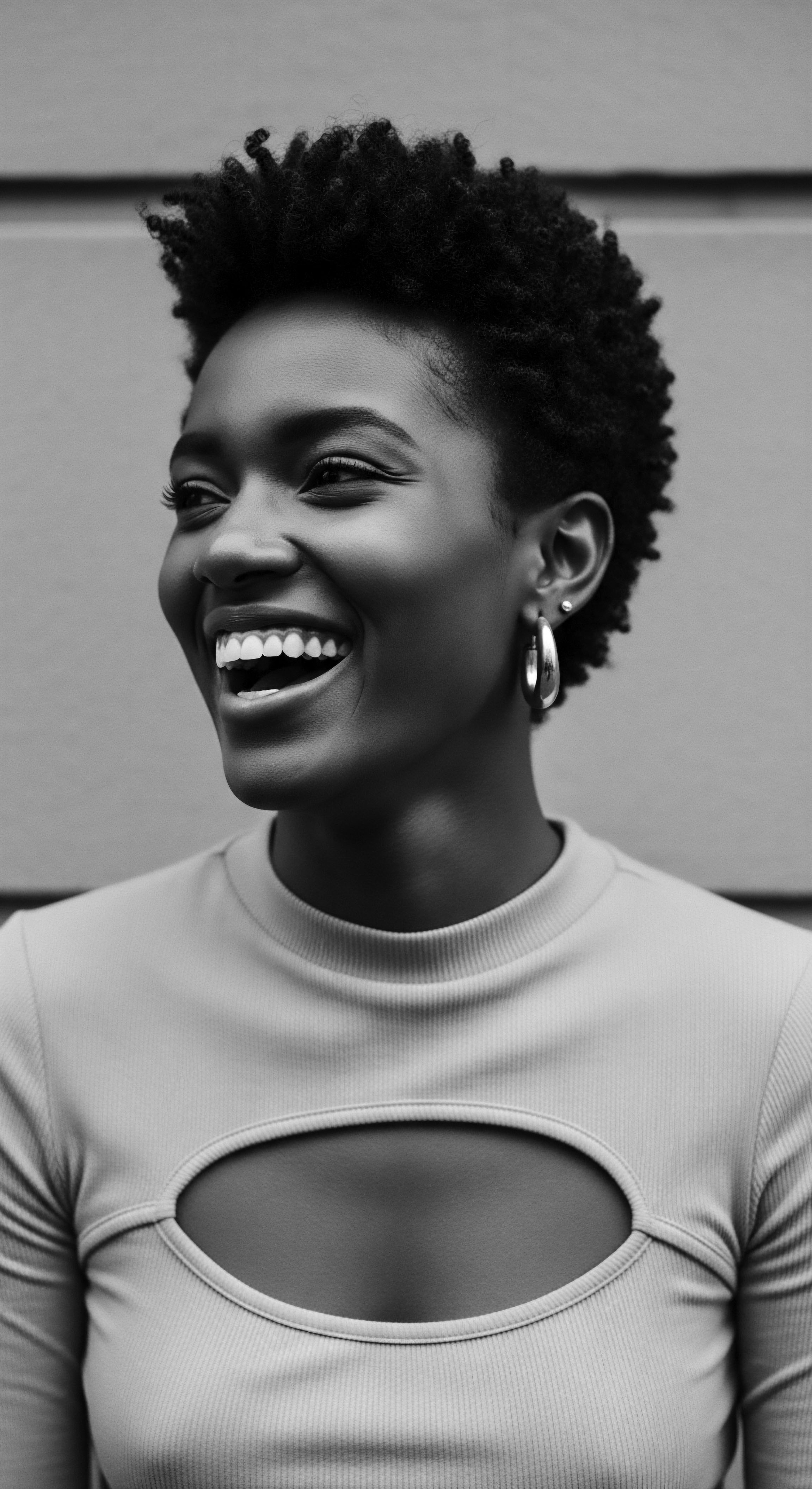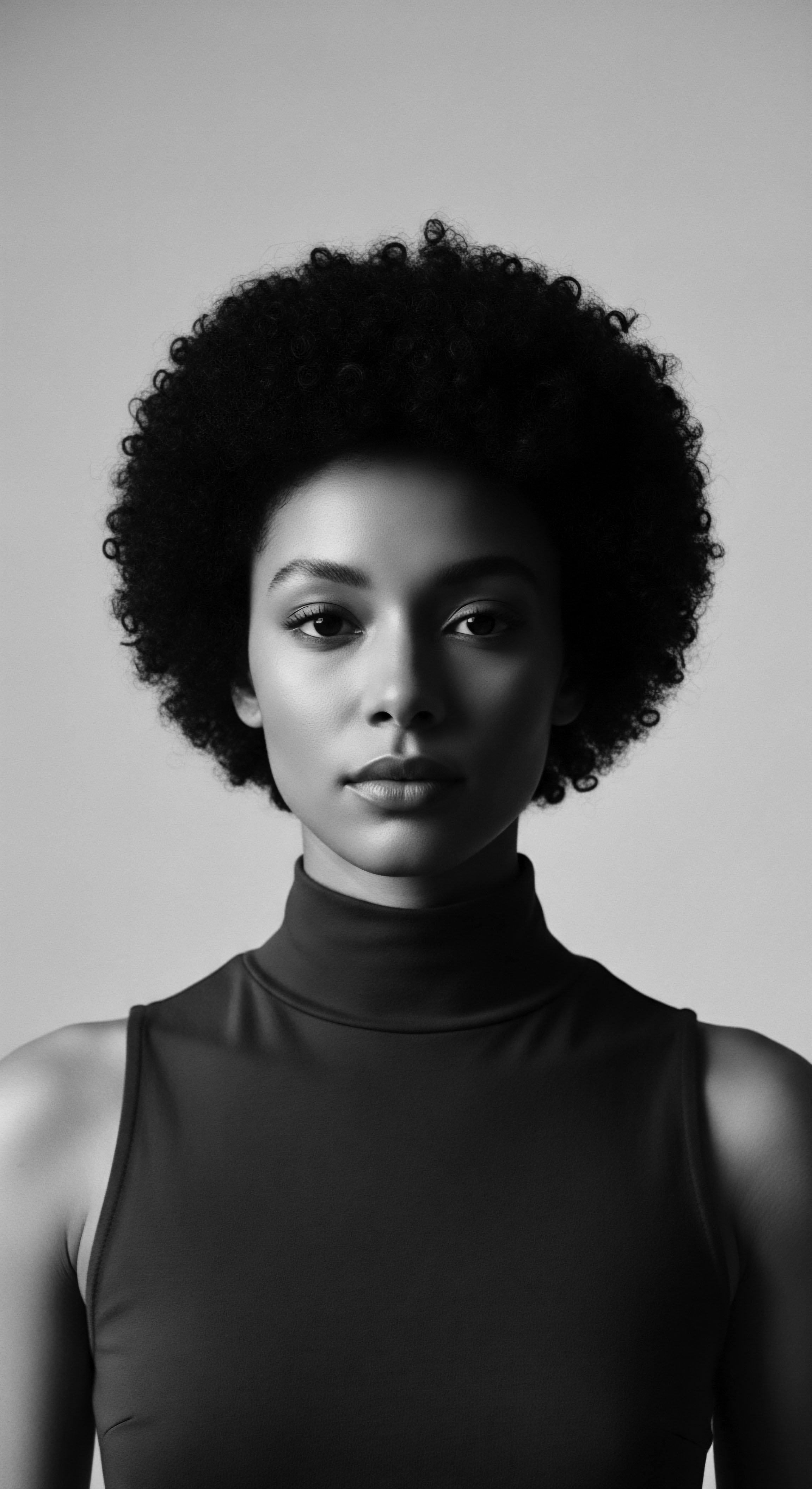
Roots
To truly understand the journey of textured hair, one must first listen to the echoes from the source, the deep whispers of the past that shaped what we now call “protective styles.” These are not mere trends, born of fleeting fads or convenience. No, these ways of caring for and adorning hair are, at their very core, a dialogue with ancestry, a living archive of resilience and identity passed down through countless generations. For many Black and mixed-race people, our hair holds narratives of survival, spirit, and connection. It stands as a testament to the ingenuity and enduring cultural wealth that transcended continents and centuries of upheaval.
From the earliest human settlements, hair served as more than just a biological appendage; it was a canvas of communication, a marker of belonging, and a conduit to the unseen. In ancient African societies, a person’s hairstyle could tell an entire story ❉ their marital status, age, community role, wealth, or even spiritual leanings. Byrd and Tharps (2020) note that intricate hairstyles in these communities often indicated social rank and religious beliefs.
These elaborate styles, many of which were the genesis of what we recognize as protective styles today, took hours, sometimes even days, to craft. This communal styling experience also fostered deep social bonds, transforming a practical need into a vital social ritual.

What is the Elemental Biology of Textured Hair?
At its most fundamental level, textured hair possesses a unique biological architecture that renders protective styling not just an aesthetic preference, but a practical necessity for health and length retention. The elliptical cross-section of a textured hair strand, coupled with its twisted and coiled growth pattern, makes it inherently more susceptible to dryness and breakage compared to straighter hair types. Each bend and coil creates potential points of vulnerability where the cuticle, the hair’s outer protective layer, can lift, making it harder for natural oils to travel down the strand.
This anatomical distinction means that external protection from environmental stressors and daily manipulation becomes particularly significant. Without this thoughtful safeguarding, textured hair can struggle to retain moisture, leading to brittleness and fracture.

How Did Early Communities Practice Textured Hair Care?
Ancestral communities understood the unique needs of textured hair long before modern science articulated the specifics. Their practices, honed over millennia, reveal a profound, intuitive grasp of hair biology. These early approaches were deeply intertwined with their environment, utilizing local botanicals, natural oils, and clays for cleansing, conditioning, and protection.
Think of the Himba people of Namibia, whose distinctive red-pigmented strands, often shaped with otjize paste (a mixture of butterfat, ochre, and aromatic resins), served not only as a cultural emblem but also offered real protection against the harsh sun. Hair was anointed with substances that both nourished and sealed, methods passed down through oral tradition and practiced within the family unit.
Protective styles emerged from ancient wisdom, recognizing the unique needs of textured hair to thrive amidst environmental challenges and societal narratives.
The practice of grouping and securing hair, whether through braiding, twisting, or coiling close to the scalp, minimized exposure to dust, sun, and tangling. This was a form of preservation, allowing hair to grow undisturbed. The earliest drawings of braids in Africa, for instance, were found in Ancient Egypt, dating back to 3500 BCE.
These early styles were not simply adornments; they were functional designs, born from an innate understanding of how to sustain hair vitality within diverse climates. This foundational knowledge, passed down quietly across generations, forms the initial strata of our understanding of protective styles.
| Historical Practice Scalp-hugging Coils |
| Purpose and Heritage Connection Minimized hair exposure and tangling; often indicated tribal affiliation or marital status. |
| Historical Practice Natural Oils and Butters |
| Purpose and Heritage Connection Provided moisture retention and external protection from dry climates; tied to local flora and ancestral knowledge of plant properties. |
| Historical Practice Intricate Plaiting Systems |
| Purpose and Heritage Connection Organized hair for long-term wear, reduced manipulation; served as visual language for social standing and community identity. |
| Historical Practice These foundational practices rooted hair care in a holistic, heritage-centered approach, blending physical need with cultural expression. |

Ritual
The journey of protective styles moves beyond initial biological imperatives, deepening into the realm of shared human experience and communal bonding. Hair styling, particularly for textured hair, transformed into a powerful ritual, a tender thread connecting individuals to their lineage, their community, and even the spiritual world. It was a space for storytelling, for the quiet transfer of wisdom from elder to youth, and for the forging of unbreakable social ties.

How Has Collective Styling Influenced Hair Traditions?
For centuries, the act of styling hair was rarely a solitary endeavor. It was a gathering, a salon beneath a tree, on a porch, or within family homes. Women, children, and sometimes men, would spend hours in these sessions. This collective activity provided a setting for oral histories to flow, for societal values to be reinforced, and for specific styling techniques to be imparted.
Learning to braid, twist, or adorn hair was often a rite of passage, signifying a young girl’s transition into womanhood. The communal nature of hair care cemented styles within the cultural fabric, ensuring their preservation through practice and memory.
Consider the cornrow, a style of profound historical significance. Depictions of women with cornrows date back to Stone Age paintings in the Tassili Plateau of the Sahara, as early as 3000 BCE. This pattern, laid close to the scalp, was not simply decorative. Its precision and durability offered significant protection to the hair strands, keeping them tucked away from environmental harm.
Different patterns could also communicate intricate social information. In some Yoruba traditions, cornrows were known as ‘Kolese’ braids, meaning “a creature without legs,” possibly referring to their stationary nature.

How do Traditional Protective Styles Represent Cultural Identity?
Specific protective styles became living emblems of cultural identity. The variations across different ethnic groups in Africa were vast, each possessing unique names, techniques, and symbolic meanings. These styles were a visual lexicon, signifying tribal affiliation, marital status, age, wealth, and even spiritual devotion. The care involved in these creations reflected the high esteem in which hair was held, often seen as the highest point of the body and closest to the divine.
Some prominent styles rooted in this cultural heritage include:
- Shuku (Nigeria) ❉ A braided crown style that rises at the center of the head, often complemented by intricate patterns. Historically reserved for queens or women of high social standing.
- Fulani Braids (West Africa) ❉ Characterized by cornrows that typically run from front to back, often with a central cornrow, adorned with beads, cowrie shells, or other embellishments. These styles served as a sign of beauty, strength, and independence among the nomadic Fulani people.
- Bantu Knots (Southern Africa) ❉ A style where hair is sectioned, twisted, and wrapped to form a knot-like appearance. The term “Bantu” universally means “people” across many African languages. These knots can be traced back to the 2nd millennium BCE, symbolizing strength and community.
The ritual of hair styling became a dynamic expression of lineage, where each braid and twist carried the weight of communal history and individual identity.
These practices extended beyond the African continent. As African people were forcibly displaced during the transatlantic slave trade, they carried their styling traditions with them. Despite efforts to strip them of their cultural markers, enslaved Africans held fast to their hair practices as a profound act of resistance and preservation. Cornrows, for instance, became a secret language, used to map escape routes or hide seeds for survival, an extraordinary testament to their ingenuity and the symbolic weight of their hair.

Relay
The story of protective styles, as it moves through generations, is a powerful relay, carrying the torch of heritage through periods of immense challenge and into contemporary expression. This journey highlights not only the enduring nature of these practices but also their remarkable adaptability, consistently proving their relevance in new contexts. The wisdom of ancestors, once a whisper, becomes a resonant declaration through these styles, shaping modern understanding and advocating for cultural recognition.

How Did Protective Styles Persist through Historical Oppression?
The era of the transatlantic slave trade marked a dark turning point, yet it also underscored the incredible resilience embedded within textured hair heritage. Upon capture, African individuals often had their heads shaved, an act of intentional dehumanization and cultural erasure, severing a vital connection to identity and spiritual power. Despite these brutal attempts to strip away their personhood, enslaved Africans maintained their hair practices, adapting them in secret, utilizing what few resources were available. This continuity, often in defiance of oppressive forces, stands as a testament to the deep-seated significance of hair in their lives.
In the Americas, protective styles became clandestine forms of communication and survival. Cornrows, in particular, served as covert maps, with patterns indicating routes to freedom, safe havens, or even carrying hidden seeds for sustenance during perilous escapes. This extraordinary example reveals how hair transformed into a tool of direct resistance, a silent language understood by those seeking liberation. The persistence of these styles, even under the most harrowing conditions, speaks volumes about their integral role in preserving a sense of self and community when all else was threatened.

What is the Modern Validation of Traditional Hair Practices?
Modern science now offers validation for many ancestral hair care traditions, reinforcing what generations already understood intuitively. The tightly coiled structure of textured hair, while beautiful, is prone to tangling and moisture loss. Protective styles, by tucking away delicate ends and minimizing daily manipulation, demonstrably reduce breakage and retain length.
This protective function shields hair from environmental stressors such as harsh weather and friction, creating an optimal environment for growth. A study examining the efficacy of protective styles confirms their role in length retention by reducing damage, though they do not directly accelerate hair growth (Cécred, 2024).
From ancient survival to modern affirmation, protective styles have consistently served as a testament to the enduring spirit and adaptability of textured hair heritage.
The contemporary natural hair movement, a powerful reawakening, has seen a resurgence of these traditional practices. It represents a collective embrace of ancestral beauty and a rejection of Eurocentric beauty standards that historically marginalized textured hair. This movement highlights how styles like braids, twists, and locs are not merely aesthetic choices, but a conscious connection to lineage, a reclaiming of identity, and a celebration of natural beauty.
Legal efforts, such as the CROWN Act (Creating a Respectful and Open World for Natural Hair), passed in various states, underscore this societal shift, prohibiting discrimination based on hair texture and protective styles. This legislative movement acknowledges the historical prejudice against Black hair and safeguards the right to express cultural heritage through hair in professional and educational settings.
| Dimension Cultural Code |
| Historical Significance Communicated social status, age, tribal affiliation, spiritual beliefs. |
| Contemporary Significance Expression of Black and mixed-race identity, cultural pride, and ancestral connection. |
| Dimension Survival & Resistance |
| Historical Significance Used as covert maps, hiding provisions during slavery; defiance against forced assimilation. |
| Contemporary Significance Symbol of self-acceptance, political statement against hair discrimination (CROWN Act). |
| Dimension Hair Health |
| Historical Significance Practical protection from environmental elements; intuitive understanding of hair needs. |
| Contemporary Significance Scientifically validated method for length retention, reduced breakage, and low manipulation. |
| Dimension The enduring principles of protective styling continue to bridge the historical and the present, underscoring a deep cultural legacy. |
The continuity of these styles, from ancient African kingdoms to the modern diaspora, is a testament to their inherent value and the persistent spirit of the communities that sustain them. It represents a living, breathing heritage, always evolving yet always rooted.

Reflection
As we ponder the winding path of protective styles, we sense a profound truth ❉ these are more than just arrangements of hair. They are, truly, a living archive, each braid, twist, and coil holding echoes of ingenuity, struggle, joy, and deep connection. The journey from elemental biology and ancient practices to the bold assertions of identity in our modern world paints a vivid picture of a heritage that refuses to be silenced or forgotten.
The Soul of a Strand reveals itself in this journey—the understanding that textured hair carries within its very helix the wisdom of those who came before us. It reminds us that care for our hair is not a superficial act; it is an honoring of lineage, a preservation of culture, and a declaration of self. These styles are conversations with our past, expressions of our present, and pathways to our future, constantly reminding us of the strength and beauty inherited through generations.
The historical origin of specific protective styles is a testament to humanity’s capacity for creativity and resilience, particularly within Black and mixed-race communities. It speaks to a profound connection between self and ancestry, a bond that continues to shape our understanding of beauty, wellness, and belonging.

References
- Byrd, A. & Tharps, L. L. (2020). Hair Story ❉ Untangling the Roots of Black Hair in America. St. Martin’s Press.
- Dabiri, E. (2020). Twisted ❉ The Tangled History of Black Hair Culture. Harper Perennial.
- Davis-Sivasothy, A. (2011). The Science of Black Hair ❉ A Comprehensive Guide to Textured Hair Care. Sivasothy Publishing.
- Ellington, T. (2020). Textures ❉ The History and Art of Black Hair. Cooper Hewitt, Smithsonian Design Museum.
- Greene, D. W. (2022). #freethehair ❉ how black hair is transforming state and local civil rights legislation. Nevada Law Journal, 22(3), 1117-1150.
- Rooks, N. (1996). Hair Raising ❉ Beauty, Culture, and African American Women. Rutgers University Press.
- Sherrow, V. (2023). Encyclopedia of Hair ❉ A Cultural History, 2nd Edition. Greenwood.
- Sieber, R. & Herreman, F. (Eds.). (2000). Hair in African Art and Culture. Museum for African Art.
